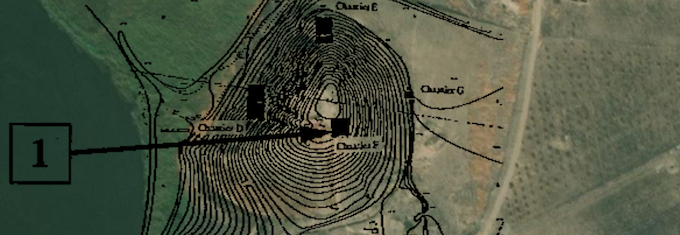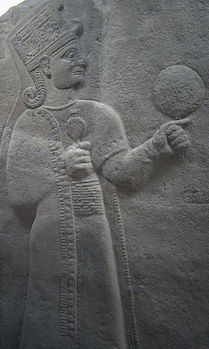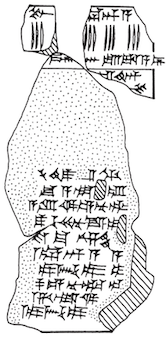You are seeing an unstyled version of this site. If this is because you are using an older web browser, we recommend that you upgrade to a modern, standards-compliant browser such as FireFox [http://www.getfirefox.com/], which is available free of charge for Windows, Mac and Linux.
Neo-Assyrian Archival Texts from Burmarina

Between 1994 and 1998, Luc Bachelot (Paris), and Frederick Mario Fales (Udine) directed the French-Italian salvage excavations at Burmarina (modern Tell Shiukh Fawqani) on the eastern bank of the Euphrates, close to the modern border between Syria and Turkey. From 1995 to 1997, a sizeable number of fragmentary clay tablets inscribed in Assyrian cuneiform (forty-four texts) and in Aramaic alphabet script (nineteen texts) were unearthed. This mix of cuneiform and alphabetic writing is typical for the western provinces of the Assyrian Empire and can also be observed, for example, at Dur-Katlimmu [/atae/durkatlimmu/] (modern Tell Sheikh Hamad).

The goddess Kubaba, holding a pomegranate in her right hand and a mirror in her left, as depicted on a relief from the so-called Herald's Wall at Carchemish. Museum of Anatolian Civilizations, Ankara. Photo Credit: Georges Jansoone.
The Burmarina tablets are relatively poorly preserved because, unlike many other archival texts from the Neo-Assyrian Period, they were not accidentally exposed to fire. This is what typically happened to archives that were in use when the Assyrian Empire ended in warfare, violence and very often fire blazes in the late 7th century BC. But the Burmarina texts are considerably older. Although there are only a few year dates preserved what is available allows a firm dating of the tablets to the reign of Esarhaddon [/rinap/rinap4/] (r. 680–669 BC), with the eponyms Issi-Adad-anenu for the year 679 BC, Banbâ for 676 BC and Atar-ili for 673 BC attested. Is there perhaps a connection with the end of the Burmarina archives and Esarhaddon's suppression of the 671/670 rebellion [/saao/knpp/essentials/esarhaddon/index.html] against his rule?
All of the clay tablets recovered at Burmarina are legal documents. Most of the Assyrian cuneiform texts are sale contracts (of which sometimes only tiny fragments have been preserved) but there are also debt notes for silver and texts documenting various stages of litigation between parties raising claims against each other. No clear central figure emerges from these tablets so it is difficult to describe them as a coherent archive. The cavalryman Kubaba-lidi is most often attested in a key function, as the buyer in three texts (TSF 1–2 and 12 [/atae/burmarina/P522614,P522615,P522625]) and as the plaintiff in a fourth (TSF 37 [/atae/burmarina/P522650]) while Mannu-ki-ahi is twice attested as creditor (TSF 33–34 [/atae/burmarina/P522646,P522647]) and again as one of the parties in a judicial text (TSF 41 [/atae/burmarina/P522654]). The relationship between these men and the various other people attested in key functions in the Burmarina documentation is unclear.
About twenty kilometers upstream from Burmarina lies the great city of Carchemish. For the people living in the smaller settlement, its ancient temple dedicated to the goddess Kubaba was the most important place of worship. This is clear from one of the Assyrian documents from Burmarina, as it stipulates that whoever breaks the contract must pay twenty mines of refined silver and ten mines of purified gold "to the goddess Kubaba who resides in Carchemish" (TSF 3 [/atae/burmarina/P522616]). At Burmarina, the deity is also attested in the inhabitants' names, such as Kubaba-gamil and the afore-mentioned Kubaba-lidi.

Hand-drawn facsimile of the obverse of TSF 97 F 200/126+209+220 (TSF 1 [/atae/burmarina/P522614]), a sales contract between Kubaba-lidi and Babilāyu (dated to 673 BC)
The Assyrian and Aramaic tablets from Burmarina were published by Frederick Mario Fales, Karen Radner, Cinzia Pappi, and Ezio Attardo, "The Assyrian and Aramaic Texts from Tell Shiukh Fawqani," [https://epub.ub.uni-muenchen.de/25037/] pp. 595–694 in Luc Bachelot and Frederick Mario Fales (eds.), Tell Shiukh Fawqani 1994–1998, Padua, 2005. On the goddess Kubaba in the Burmarina texts, see Karen Radner, "Kubaba und die Fische: Bemerkungen zur Herrin von Karkemiš," [https://epub.ub.uni-muenchen.de/25034/] pp. 543–556 in Robert Rollinger (ed.), Von Sumer bis Homer: Festschrift für Manfred Schretter (Alter Orient und Altes Testament 325), Münster, 2005.
The editions presented on ATAE/Burmarina have been adapted from the source publication from files kindly provided by Karen Radner.
Click here [/atae/burmarina/pager] to browse the Burmarina corpus.
ATAE is a key component of the Archival Texts of the Middle East in Antiquity (ATMEA) sub-project of the LMU-Munich-based Munich Open-access Cuneiform Corpus Initiative [https://www.en.ag.geschichte.uni-muenchen.de/research/mocci/index.html] (MOCCI; directed by Karen Radner and Jamie Novotny). Funding for the ATAE corpus project has been provided by LMU Munich and the Alexander von Humboldt Foundation (through the establishment of the Alexander von Humboldt Chair for Ancient History of the Near and Middle East).
For further details, see the "About the project" [/atae/abouttheproject/index.html] page.

Home Page banner credit
Satellite image of the ruins of Burmarina overlaid with general plans of the archives and libraries (Pedersén, Archives and Libraries in the Ancient Near East 1500-300 B.C. p. 178 Plan 86). Image prepared by Jamie Novotny.
Karen Radner
Karen Radner, 'Neo-Assyrian Archival Texts from Burmarina', Neo-Assyrian Archival Texts from Burmarina, The ATAE/Burmarina Project, a sub-project of MOCCI, 2023 [http://oracc.org/burmarina/]